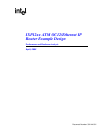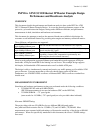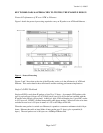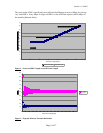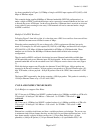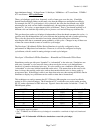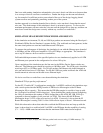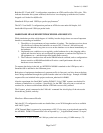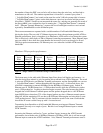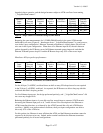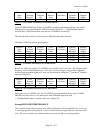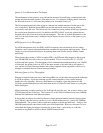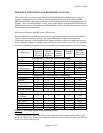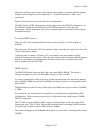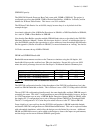
Version 1.0, 4/10/02
Page 3 of 17
IXP12xx ATM OC12/Ethernet IP Router Example Design
Performance and Headroom Analysis
OVERVIEW
This documents details the performance and headroom analysis done on the IXP12xx ATM
OC12 / Ethernet IP Router Example Design. It covers the general performance aspects of the
protocols; cycle and instruction budgets; testing under different workloads; and performance
measurements in both, simulation and hardware environments.
This document also attempts to analyze the amount of headroom available in this design for
customers to add additional features by providing microengine and memory utilization metrics.
Three different configurations are supported:
One ATM OC-12 port &
eight 100Mbps Ethernet ports
For use with the IXP1240/1250 with hardware CRC capability
Four ATM OC-3 ports &
eight 100Mbps Ethernet ports
Similar to the above configuration (requires the IXP1240/50), except
that it uses four OC-3 ports.
Two ATM OC-3 ports &
four 100Mbps Ethernet ports
For use with the IXP1200 (which does not have hardware CRC
capability). Instead, CRC computation is performed by two
microengines (thus the reduced data rates).
Since in each configuration aggregate Ethernet port bandwidth exceeds aggregate ATM port
bandwidth, ATM port bandwidth is the limiting external factor. This example design supports
full-duplex, full-bandwidth ATM communication on all available ATM ports.
The design is able to simultaneously transmit and receive any traffic pattern on all available ATM
ports at line rate. Line rate means that no idle cells should appear on the ATM links.
Furthermore, no ATM PHY FIFO overflows or Ethernet MAC FIFO overflows or underflows
should occur.
MEASUREMENT ENVIRONMENT
Simulation and hardware performance testing was performed under the following conditions:
o 232 MHz IXP1240 with an 80 MHz IX Bus
(IXP1200 measurements do not use the hardware-CRC on the IXP1240)
o 133 MHz SDRAM – ‘-75’ speed-grade
(some results for 143 MHz (‘-7E’ speed-grade) are also provided where indicated)
Alternate DRAM Timing
The project ships with two FLASH files for two different DRAM speed grades.
atm_ether\tools\flash contains files for 133MHz (-75) and 143 MHz (-7E) DRAM. Most
measurements were repeated with both settings to illustrate the sensitivity of the design to DRAM
performance. Where not specifically mentioned in this document, the slower 133MHz settings
were used.



